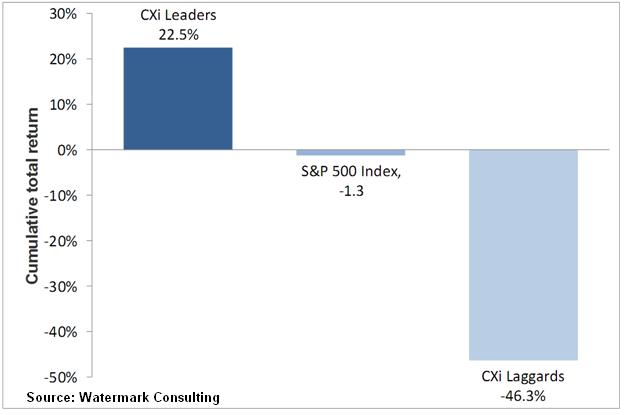When It Comes to Total Returns, Customer Experience Leaders Spank Customer Experience Laggards
Whenever I talk about the business impact of customer experience, there’s one thing that always grabs people’s attention. It’s an analysis done by Jon Picoult of Watermark Consulting, who took five years of data from Forrester’s Customer Experience Index and constructed two model portfolios. One is a portfolio of the top 10 publicly traded companies in the index (customer experience leaders), and one is a portfolio of the bottom 10 publicly traded companies in the index (customer experience laggards).
You can read details of how Jon conducted his analysis in our new book, Outside In, and in this post on Jon’s blog. The results are striking. Over the course of the five-year period, the customer experience leaders spanked the laggards in stock performance. The leader portfolio had a cumulative total return of +22.5%, compared with a -1.3% decline for the S&P 500 market index and a -46.3% decline for the laggard portfolio.
Five-Year Stock Performance Of Customer Experience Index (CXi) Leaders Versus Laggards Versus S&P 500 (2007 to 2011)

What follows is an interview I recently conducted with Jon to get his thoughts on why making a compelling business case for customer experience is so challenging — and so important.
Harley: What drove you to do your analysis of the impact of customer experience on stock performance?
Jon: It always disturbed me that many companies, and the executives who led them, viewed the benefits of a great customer experience as “soft” — something that couldn’t be quantified, like the expense savings one would project from a site closure or an equipment upgrade.
But what really troubled me was that the same companies and executives were more than willing to take a leap of faith when it came to other types of business decisions that had an uncertain return on investment (ROI) — things like mergers, acquisitions, or the hiring of a star CEO with stratospheric compensation.
I knew there was one language that most of these executives (particularly the CFOs holding the purse strings) would understand — shareholder value. And so it made me wonder, could the ROI of customer experience differentiation be demonstrated through the relative stock performance of customer experience leaders and laggards? That was the genesis of the Watermark study.
Harley: What are the top things companies should take away from your analysis?
Jon: First, engage in some self-reflection. When it comes to customer experience excellence, are you really putting your money where your mouth is? Or are you paying lip service to the concept, in light of some deep-rooted skepticism about the value of a better brand experience?
Second, let the results of the analysis really sink in. What we’re seeing is no short-term performance anomaly. With five years of data under our belt, there’s clearly a long-term performance advantage being enjoyed by the companies that do this well. Hopefully that will help diminish some of the skepticism that lingers in the C-suite.
Third, recognize the breadth of factors that are driving the leaders’ outperformance, as that might help your own company quantify the value of proposed customer experience improvements. The leading firms in this analysis aren’t just enjoying higher revenues from happy satisfied customers and word-of-mouth referrals. They’re also benefiting from more competitive cost structures, driven by fewer complaints and lower business acquisition expenses, among other things. There’s a very real economic calculus underlying customer experience ROI. It just takes some work to reveal it.
Harley: We often get the question, “Why isn’t it obvious that a superior customer experience leads to profits?” How would you answer that?
Jon: I think there are two reasons. The first is the nature of that customer experience calculus, which requires a cross-silo view of the world. The experience improvement “lever” you pull in one organizational compartment may end up generating returns in an entirely different business unit, function, or geographic location. The measures many companies use to evaluate performance (or justify new initiatives) are blind to these upstream and downstream benefits. As a result, people start to think that a better customer experience doesn’t generate any value. But that conclusion is an artifact of parochial performance measures.
The second reason is that people see examples in the marketplace of companies that seem to do quite well, even though their customer experience leaves a lot to be desired. And so it begs the question, why invest in a better experience? If you can make good money by deliberately underinvesting in your customer experience, why not do that?
But this argument is flawed. The marketplace is littered with the corpses of companies who thought an “OK” customer experience would suffice.
Harley: What types of companies do you see embracing customer experience as a business discipline today, and why are they doing it?
Jon: I typically see two triggers.
First are the companies that do it because their hand is forced. Based on their own market position and/or broader competitive dynamics, they come to realize that most sources of business differentiation are rather fleeting. A really good, consistent, and intentional customer experience requires the careful coordination of lots of organizational ingredients — hiring practices, business processes, metrics, recognition programs, etc. For that reason, the experience can be a lot harder for a competitor to copy, compared with product and technology innovations.
Second (and much more nobly) are the companies run by people who simply have a deep-seated passion for this stuff — people for whom customer experience is neither buzzword nor initiative-du-jour. It’s just part of their DNA, and they’re intent on putting the customer at the center of everything they do.
Harley: When someone at a large company asks you to help them improve their customer experience, where do you typically tell them to start?
Jon: I think it’s helpful to start with the end in mind. So I encourage executives to think about what they’d like their company to be famous for. What brand attributes and characteristics do they want to lay claim to, staking out that ground like no one else does? This helps inform the design of the experience, because ideally you want every key customer touchpoint to exude those brand qualities.
